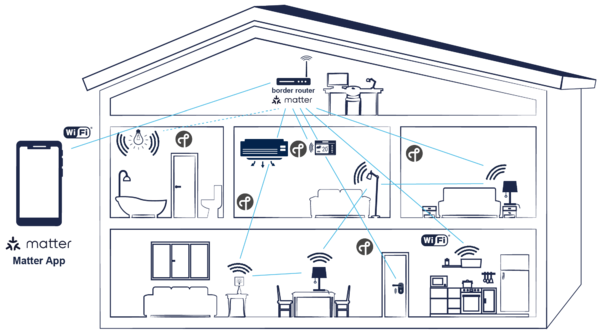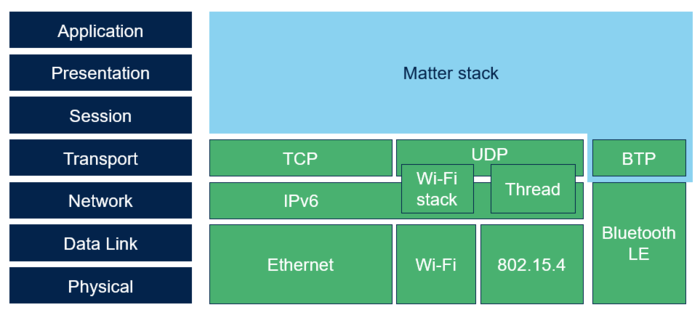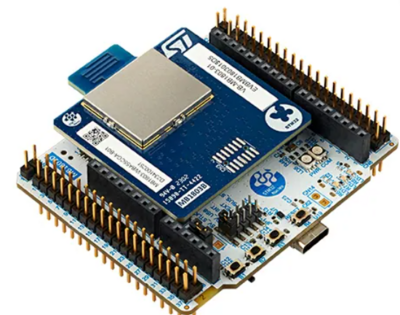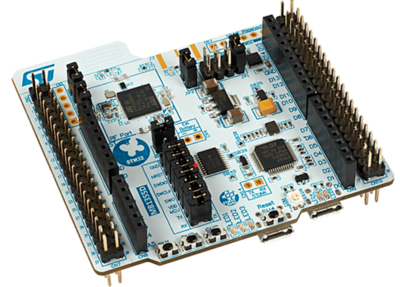1. Introduction to Matter
1.1. Introduction
Matter is a new technology for smart home that enables different devices to collaborate seamlessly, without being restricted by their brand or manufacturer. It is designed to simplify the smart home experience while maintaining security and privacy.
One of the benefits of Matter is that it is an open standard, which means that any device manufacturer can use it. Matter is an initiative of the Connectivity Standards Alliance (CSA), developed through a collaboration among all the leaders of the IoT industry.
Matter is an application protocol that relies on IPv6 and runs on top of different network interface technologies, such as Thread®, Wi-Fi®, and Ethernet.
The Matter software is provided as open source by CSA and is available under GitHub.
1.2. Device roles in Matter network
Smart homes use Wi-Fi, ThreadorEthernet technologies to operate connected devices. Each device has a distinct role within the Matter network.
| Matter network |
|---|
- End devices are connected objects designed for final applications. Among them thermostats, light bulbs, door locks, and other smart home devices that can be controlled through a smart home platform.
- Bridges are devices that enable communication between devices using different communication protocols. For example, a bridge can enable communication between a device that does not use Matter (Zigbee®) and one that does use Matter fabric.
- Controllers refer to devices such as smartphones or tablets, used to connect an end device to a Matter network via Bluetooth® LE. They serve as the central hub for the smart home network.
- Thread border router is a device that acts as a gateway between a Thread network and other IP-based networks, such as the Wi-Fi or other local networks. The border router plays a crucial role in a Matter ecosystem.
1.3. Matter stack overview
The Matter protocol is designed to be compatible with existing IP-based networks, making it easier for manufacturers to adopt and integrate it into their products.
The Matter stack is composed of the following layers:
- Application: includes the application-specific functionality and user interfaces built on top of the Matter protocol. It includes the presentation and the session layers.
- Transport: includes the transport protocols used to transmit data over the network, such as TCP and UDP. BTP is provided as a transport protocol for commissioning. TCP and UDP are provided as transport protocols for operational messaging.
- Network: includes the IPv6 network layer, which provides end-to-end connectivity for devices and services on the network.
- Link: includes the data link layer, which provides the transmission of data frames over the physical layer.
The link and physical layers can vary depending upon the used network, such as Thread®, Wi-Fi®, or Ethernet.
Bluetooth® LE is used for device commissioning.
| Matter stack overview |
|---|
1.4. STM32 based Matter accessories
The STM32WBA and STM32WB series of microcontrollers are ideal for Matter networks because they can run Thread and Bluetooth® LE concurrently. Bluetooth® LE is used for device pairing, while Thread is used for operational network. Some of STM32WBA and STM32WB microcontrollers in these series are used as Matter devices, and others as RCPs (radio co-processor).
The combination of the STM32U575ZI and its network co-processor (NCP) ST67W611M1, which run Wi-Fi and Bluetooth LE concurrently, serves as a Wi-Fi-based Matter device platform.
The STM32H753ZI microcontroller, with its embedded Ethernet MAC communication interface, serves as a Matter bridge accessory.
1.4.1. STM32 microcontrollers used as Matter device
- STM32WBA65RI
Based on an Arm® Cortex®-M33 core with Arm® TrustZone®, the STM32WBA65RI microcontroller has 2 Mbyte of flash memory and 512 Kbytes of RAM. It equips the STM32WBA65I-DK1[1] Discovery kit with external flash memory, a screen, audio sensor, and audio codec.
| STM32WBA65I-DK1 Discovery kit |
|---|
- STM32U575ZI
Based on an Arm® Cortex®-M33 core with Arm® TrustZone®, the STM32U575ZI microcontroller has 2 Mbyte of flash memory and 786 Kbytes of RAM. It equips the NUCLEO-U575ZI-Q[2] Nucleo board. In the Matter use case, this board is combined with the X-NUCLEO-67W61M1[3] Wi-Fi and Bluetooth® LE combo module, to serve as Wi-Fi based Matter device.
| NUCLEO-U575ZI-Q and X-NUCLEO-67W61M1 nucleo boards |
|---|
- STM32WB5MMG
Dual-core MCU composed of an Arm® Cortex®-M0+ as radio coprocessor and an Arm® Cortex®-M4 for user application, the STM32WB5MMG module has 1 Mbyte of flash memory and 256 Kbytes of RAM to support application layer and connectivity stacks. Additionally, it features QUADSPI peripherals to extend the memory size externally. These features allow over-the-air firmware updates, regardless of the application and the connectivity stack. The STM32WB5MMG module equips the STM32WB5MM-DK[4] Discovery kit with sensors, external flash memory, a screen, and touch sensors.
| STM32WB5MM-DK Discovery kit |
|---|
1.4.2. STM32 microcontrollers used as RCP
- STM32WBA55CG
Based on an Arm® Cortex®-M33 core with Arm® TrustZone®, the STM32WBA55CG microcontroller has 1 Mbyte of flash memory and 128 Kbytes of RAM. It equips the NUCLEO-WBA55CG[5] Nucleo-64 board, which can be used as an RCP combined with an STM32MP1 to form an OpenThread Border Router (OTBR).
| NUCLEO-WBA55CG Nucleo board |
|---|
- STM32WB55RG
Dual-core MCU composed of an Arm® Cortexv-M0+ as radio coprocessor and an Arm® Cortexv-M4 for user application, it has 1 Mbyte of flash memory and 256 Kbytes of RAM to support application layer and connectivity stacks. The STM32WB55RG equips the NUCLEO-WB55RG[6] Nucleo-64 board. In the Matter use case, this board can be used as an RCP combined with an STM32MP1 to form an OpenThread Border Router (OTBR).
| NUCLEO-WB55RG Nucleo board |
|---|
1.4.3. STM32 microcontrollers used as Matter bridge devices
- STM32H753ZI
Based on the Arm® Cortex®-M7, the STM32H753ZI microcontroller has 2 Mbyte of flash memory and 1 Mbyte of RAM. It equips the NUCLEO-H753ZI[7] Nucleo-144 board. In the Matter use case, this board can be used as a bridge device.
| NUCLEO-H753ZI Nucleo board |
|---|
1.4.4. Samples for Matter demonstration
We propose several samples demonstrating the usage of Matter:
- Matter end device [8]:
This package contains several sample applications of Matter end devices. These examples are based on Matter and function as Matter accessories that communicate over an 802.15.4 Thread network, a Wi-Fi network, or an Ethernet network.
- Matter bridge [9]:
The Matter bridge sample demonstrates a Matter bridge using the NUCLEO-H753ZI board with Ethernet connectivity. It integrates non-Matter devices as endpoints on a bridge functioning as a Matter device. In the provided example, the bridged protocol is not implemented; instead, the bridged devices are simulated.
- Matter gateway STM32MP1 border router [10]:
The STM32MP1 OpenThread border router consists of a NUCLEO-WB55RG or NUCLEO-WBA55CG as radio coprocessor, and an STM32MP135F-DK Discovery kit. These components are connected through a serial connection using an FTDI cable for the NUCLEO-WB55RG or a USB cable for the NUCLEO-WBA55CG.
2. Getting started with Matter
2.1. Demonstrate ED with delivered binaries
This is the fastest way, as there is no need to compile the project.
Go through the following steps:
Step 1: Select the network interface technology (Thread or Wi-Fi)
Step 2: Select an ED platform supporting the chosen network interface technology
Step 3: Get X-CUBE-MATTER
Step 4: Get binaries corresponding to the chosen platform and application device type. For binary location, refer to the projects folder within Folder structure. For example:
- for Window-App on STM32WBA65I-DK1, the binary is stored in the binaries folder under X-CUBE-MATTER\Projects\STM32WBA65I-DK1\Applications\Matter\Window-App\Binaries
- for Lighting-App on STM32WB5MM-DK, the binary for M4 core is stored in the binaries folder under X-CUBE-MATTER\Projects\STM32WB5MM-DK\Applications\Matter\Lighting-App\Binaries, and the binary for M0 core can be found in X-CUBE-MATTER\Projects\STM32WB_Copro_Wireless_Binaries\STM32WB5x.
Step 5: Program firmware to the end devices as indicated in End devices and RCPs How To
Step 6: From now on, the device can be commissioned in the chosen Matter Fabric ecosystem presented in Test and demonstrate.
2.2. Demonstrate bridge device with delivered binaries
This is the fastest way as there is no need to compile the project.
Go through the following steps:
Step 1: Get X-CUBE-MATTER
Step 2: Get the bridge application example binary Bridge-App_debug.bin or Bridge-App_release.bin delivered in X-CUBE-MATTER (X-CUBE-MATTER\Projects\NUCLEO-H753ZI\Applications\Matter\Bridge-App\Binaries\STM32CubeIDE folder)
Step 3: Program firmware to the bridge device as indicated in Bridge devices How To
3. Acronyms and definitions
| Term | Definition |
|---|---|
| BTP | Bluetooth transport protocol |
| ED | Matter End device |
| NCP | Network Co-Processor |
| OTBR | OpenThread Border Router |
| RCP | Radio Co-Processor |
| TCP | Transmission control protocol |
| UDP | User datagram protocol |
4. References
- ↑ STM32WBA65I-DK1, STM32WBA65RI-based Discovery kit
- ↑ NUCLEO-U575ZI-Q, STM32U575ZI-based nucleo board
- ↑ X-NUCLEO-67W61M1, ST67W611M1-based expansion nucleo board
- ↑ STM32WB5MM-DK, STM32WB5MMG-based Discovery kit
- ↑ NUCLEO-WBA55CG, STM32WBA55CG-based Nucleo-64 board
- ↑ NUCLEO-WB55RG, STM32WB55RG-based Nucleo-64 board
- ↑ NUCLEO-H753ZI, STM32H753ZI-based Nucleo-144 board
- ↑ Matter end device
- ↑ Matter bridge
- ↑ STM32MP1 OpenThread border router
Pages in category "Discover Matter"
The following 6 pages are in this category, out of 6 total.







